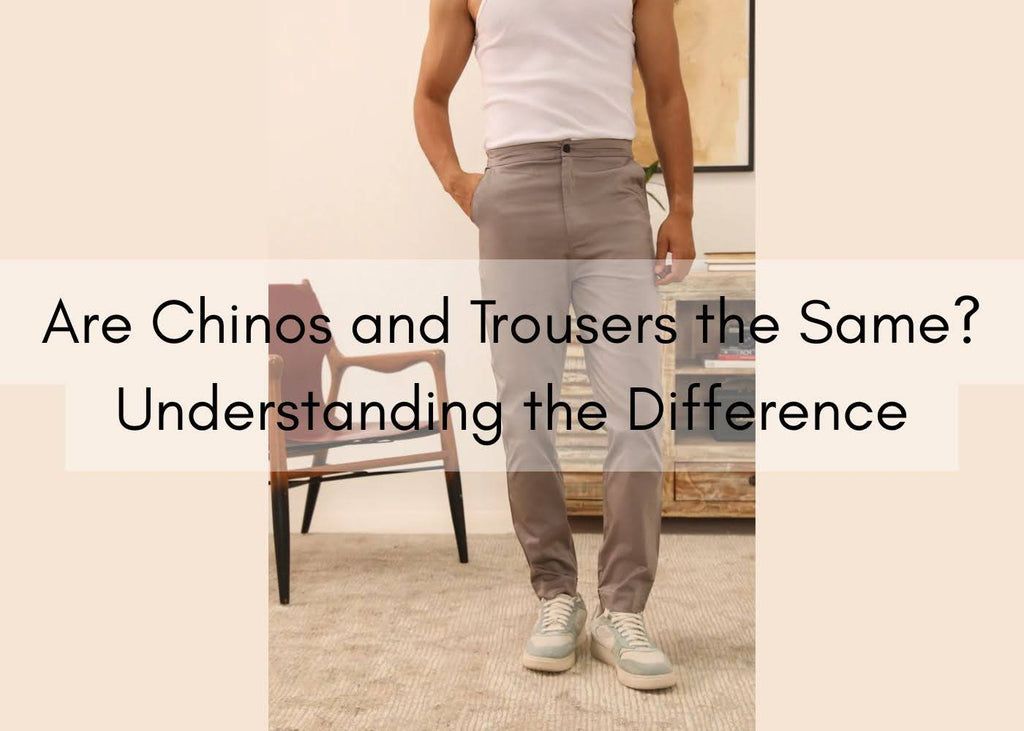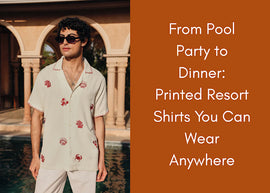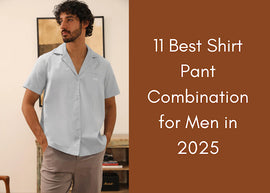Are Chinos and Trousers the Same? Understanding the Difference
Posted by Primal Gray

In everyday menswear, chinos and trousers have become visual lookalikes, often styled the same, worn interchangeably, and labelled loosely by brands chasing versatility. The overlap in design language has blurred the lines, especially with modern cuts that fuse structure with comfort. Yet the difference between the two runs deeper than fabric choice.
Chinos bring a crisp, casual refinement rooted in military utility, while trousers belong to a more structured lineage: tailored, formal, and purposefully polished. In wardrobes where clarity equals confidence, knowing which one you're reaching for isn’t a detail; it's a styling decision that defines the mood of your look. Smart casual, boardroom formal, resort-ready, or weekend relaxed, each has its place, and each sends a distinct signal.
What Exactly Are Chinos and Trousers?
Let’s break it down. Chinos are a style of pants made from lightweight cotton twill, typically designed with a streamlined silhouette. Originally military uniforms, they evolved into civilian casualwear, known for their comfort and versatility.
Trousers, by contrast, are a broader category. In British English, all pants are trousers but in fashion terms, trousers usually refer to structured, formal bottoms crafted from wool, linen, or blends.
Think of chinos as a specific type of trousers: like espresso is to coffee. All chinos are trousers, but not all trousers are chinos.
Fabric Differences
Chinos Are Cotton-Based, Trousers Vary
- Chinos are typically made from cotton twill: breathable, soft, and slightly structured. Modern variations use organic cotton, like these Slim Fit Chinos from Primal Gray, crafted from 100% GOTS-certified organic heavy cotton twill.
- Trousers come in a wider range of fabrics, from wool and wool-blends for winter suits, to linen and lycra blends for summer formals.
Fit and Construction
Chinos Lean Slim, Trousers Range Wide
-
Chinos are known for their tailored, tapered fit. Whether slim, relaxed, or jogger-style, the idea is to maintain a clean silhouette. Take Primal Gray’s Chino Joggers, they blend casual and work-appropriate design with a comfort fit that doesn’t compromise structure.
- Trousers come in many silhouettes: slim, straight, wide-leg, tapered, and even drop crotch. The Dusky Pink Drop Crotch Pants offer a flowy, relaxed structure ideal for resort or weekend wear, while Grey Baggy Trousers are more rooted in streetwear form and flexibility.
Formality Spectrum
Chinos Sit in the Middle
- Chinos are best described as smart-casual, they dress up well with button-downs and loafers, but never feel out of place with a hoodie and sneakers. Think of them as the Swiss army knife of pants.
- Trousers can be both ends of the spectrum. from ultra-formal suit trousers to laid-back loungewear. If you're aiming for office credibility or ceremonial events, structured trousers like pleated Gurkhas or flat-front wool pants win.
Styling Versatility
Chinos Are Made for Cross-Pairing
You can wear chinos just about anywhere. Here's how they hold up:
- Office: Pair navy chinos with a light-blue oxford and brogues.
- Travel: Go with Chino Joggers and a half-zip sweatshirt.
- Brunch: Match beige chinos with a Cuban collar shirt and slip-ons.
Trousers, on the other hand, are usually styled with:
- Blazers, coats, or knitwear
- Leather shoes, monk straps, or minimalist trainers
- Accessories like belts, watches, and pocket squares for dressy occasions.
Occasion Suitability
Trousers for Formal, Chinos for Flexibility
- Going to a wedding? Pick tailored trousers in neutral tones.
- Pitching a client idea? A pair of chinos with polished loafers does the job.
- Catching a flight or coffee? Chino joggers or relaxed-fit trousers with stretch fabric work best.
Care and Maintenance
Cotton vs. Blends
- Chinos are generally machine-washable and low maintenance, though organic variants (like Primal Gray’s collections) should be cared for with cold water and mild detergents.
- Trousers made of wool or linen blends might require dry-cleaning or steam ironing to retain structure.
Colour Palette
Neutrals Dominate but Trends Evolve
- Chinos often come in navy, beige, olive, khaki, and even black. All easy to pair.
- Trousers in modern styles embrace muted tones but also explore pastels (like the dusky pink Drop Crotch Pants) and textural contrasts for visual appeal.
Price Range
Not Always a Clear Difference
- Trousers used to be more expensive due to heavier fabrics, but modern brands now offer well-crafted chinos in premium finishes, blurring the price distinction.
- Choose based on usage, not just cost. Everyday wear? Go chino. Once-a-month gala dinner? Invest in trousers.
Primal Gray Makes the Chino vs Trouser Choice Effortless
Primal Gray eliminates the guesswork between structure and ease with a collection designed for every version of your day. Whether it's the Slim Fit Chinos tailored from GOTS-certified organic cotton, the flowy silhouette of the Drop Crotch Pants for off-duty ease, or the bold streetwear edge of the Grey Baggy Trousers, each piece is thoughtfully crafted to bridge purpose with polish.
Shop Primal Gray’s edit of elevated trousers and chinos, built for comfort, cut for impact.
Key Takeaways
- Chinos are a subcategory of trousers, typically made from cotton twill with a casual-to-smart-casual vibe.
- Trousers are an umbrella term, covering all pant styles from formal wool to wide-leg linen.
- Fit and fabric are the clearest differentiators, chinos are streamlined and cotton-based, while trousers vary widely.
- For versatility, chinos win, but for structured occasions, trousers take the lead.
- Chinos are easier to maintain and often better for all-day wear, especially in breathable cotton.
- Choose based on context, don't wear wide-leg baggy trousers to board meetings or slim chinos to black-tie weddings.
Frequently Asked Questions
1. Are chinos and trousers the same?
No. Chinos are a type of trousers made from cotton twill with a streamlined, semi-formal design. Trousers is a broader term that includes everything from chinos and dress pants to joggers and linen pants.
2. What is the difference between chinos and trousers?
Chinos are usually lighter, made from cotton twill, and designed for casual or smart-casual wear. Trousers can be made from wool, linen, cotton, or blends, and range from formal suits to loose-fit loungewear.
3. Are chinos considered formal trousers?
Not exactly. Chinos fall under smart-casual, suitable for work settings without strict dress codes, but not ideal for very formal occasions like black-tie events.
4. Can chinos be worn as trousers?
Yes, chinos are trousers, technically. You can wear them in any situation that doesn't demand strict formality. Add a blazer, belt, and polished shoes, and they work in most semi-formal settings.
5. What are chinos made of?
Most chinos are made from cotton twill, a breathable, durable fabric that allows movement. Many modern chinos use organic or Fair Trade cotton, like these joggers by Primal Gray.
6. What are trousers made of?
Trousers can be made from wool, linen, lycra blends, or cotton. For example, the Gurkha Pants use cotton twill and lycra, making them breathable yet stretchable for summer.
7. How to style chinos vs trousers?
Style chinos with t-shirts, polos, or casual shirts and sneakers or loafers. Trousers, depending on formality, go with dress shirts, jackets, or knitwear and are best complemented by boots or leather shoes.
8. Where to buy chinos and trousers?
You can shop chinos, joggers, Gurkha trousers, and drop crotch pants at Primal Gray, which offers eco-conscious options in versatile fits and high-quality fabrics.












